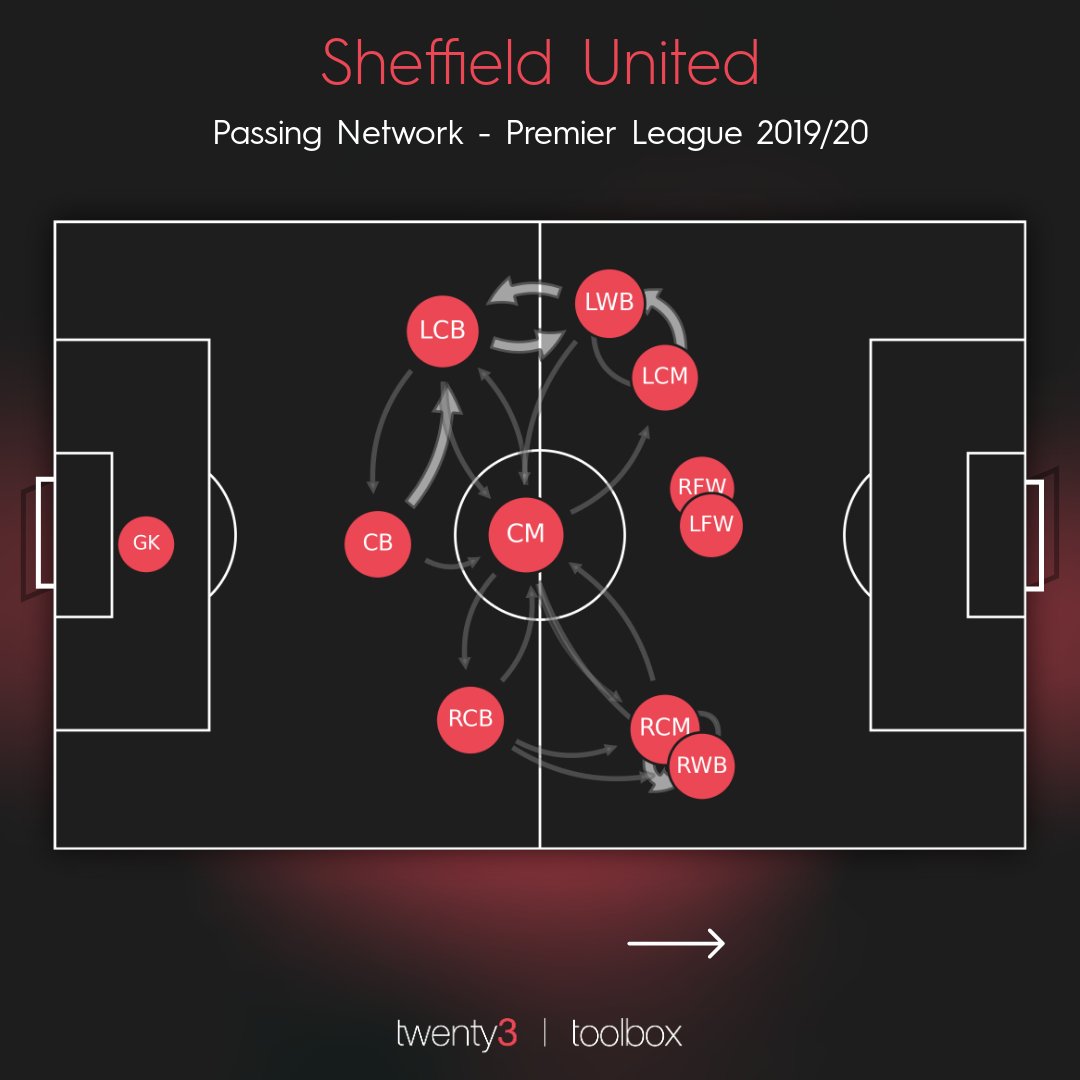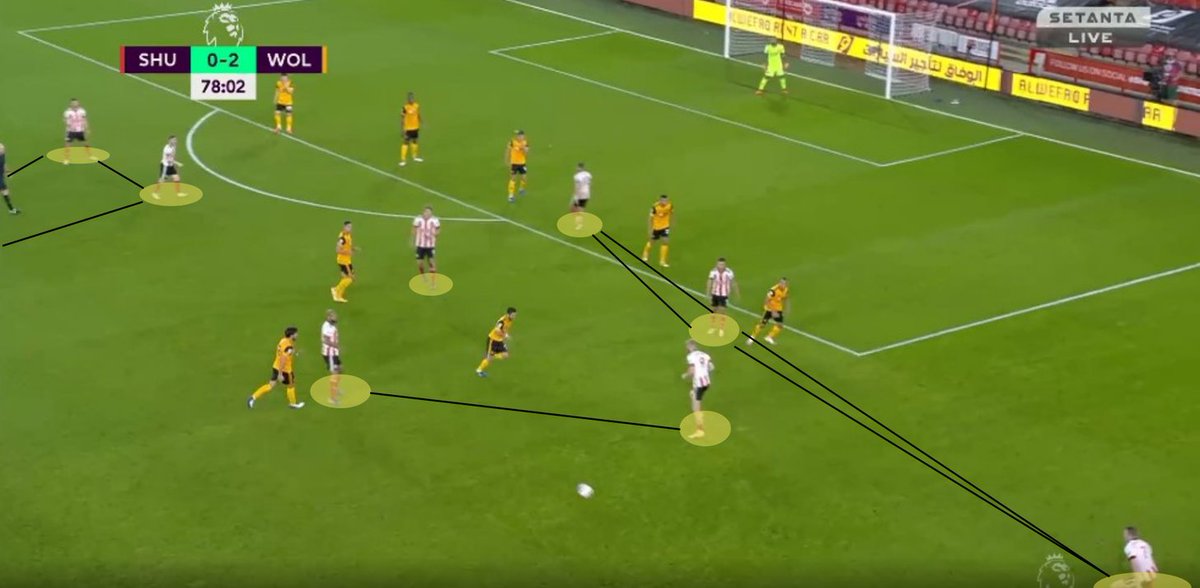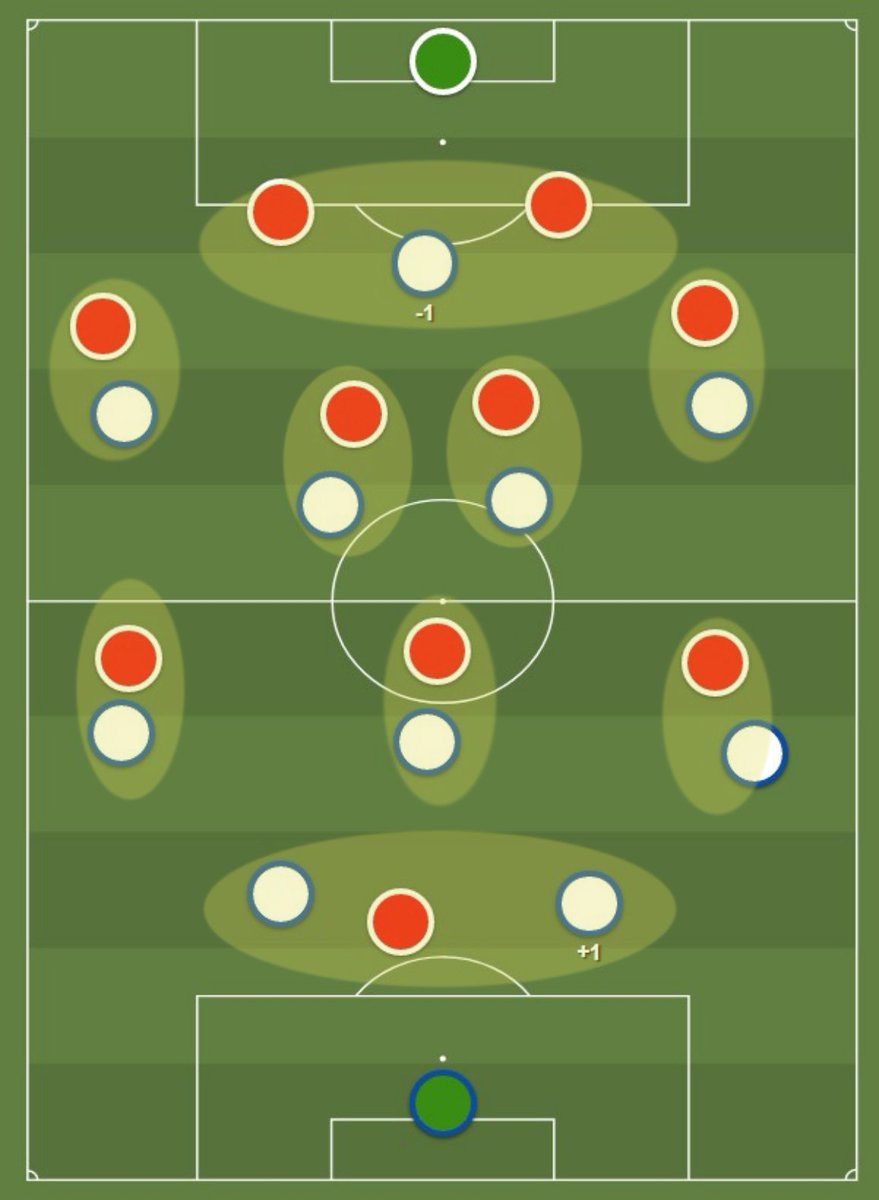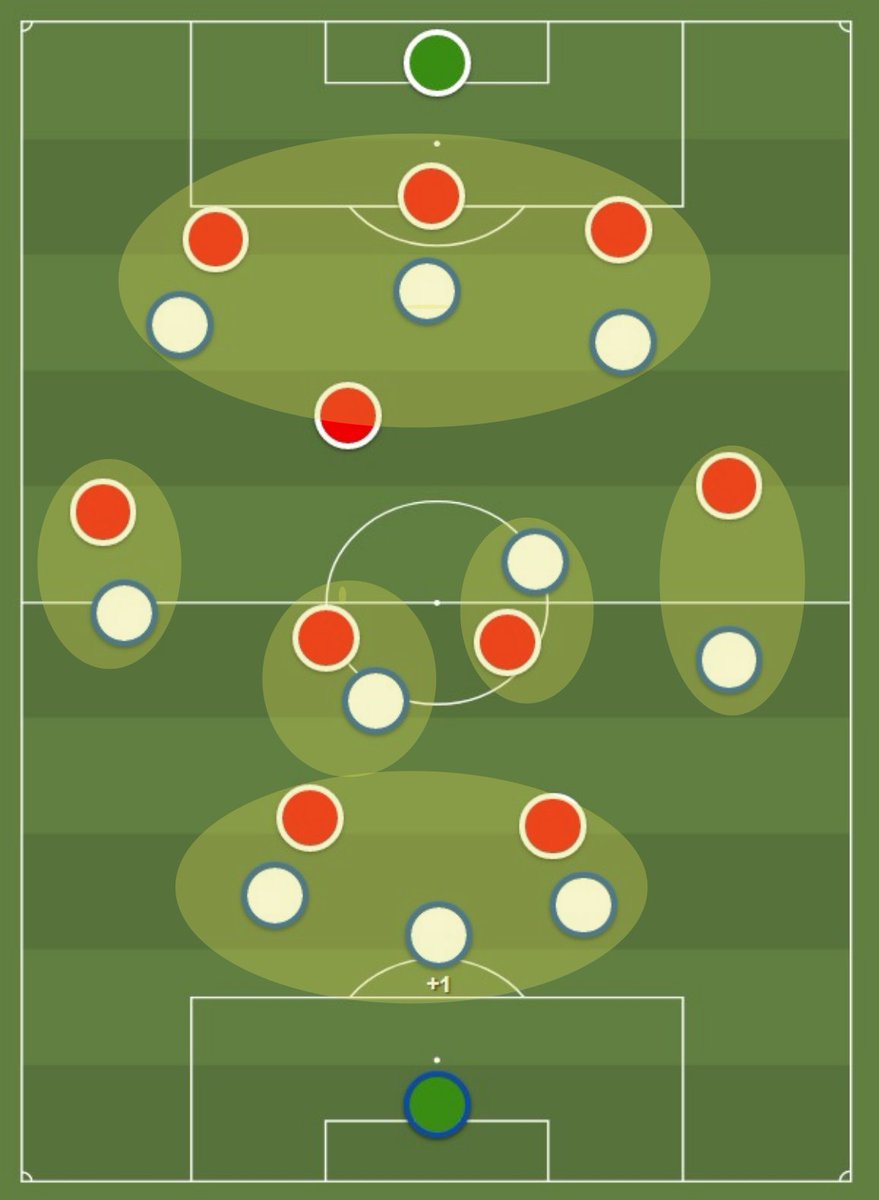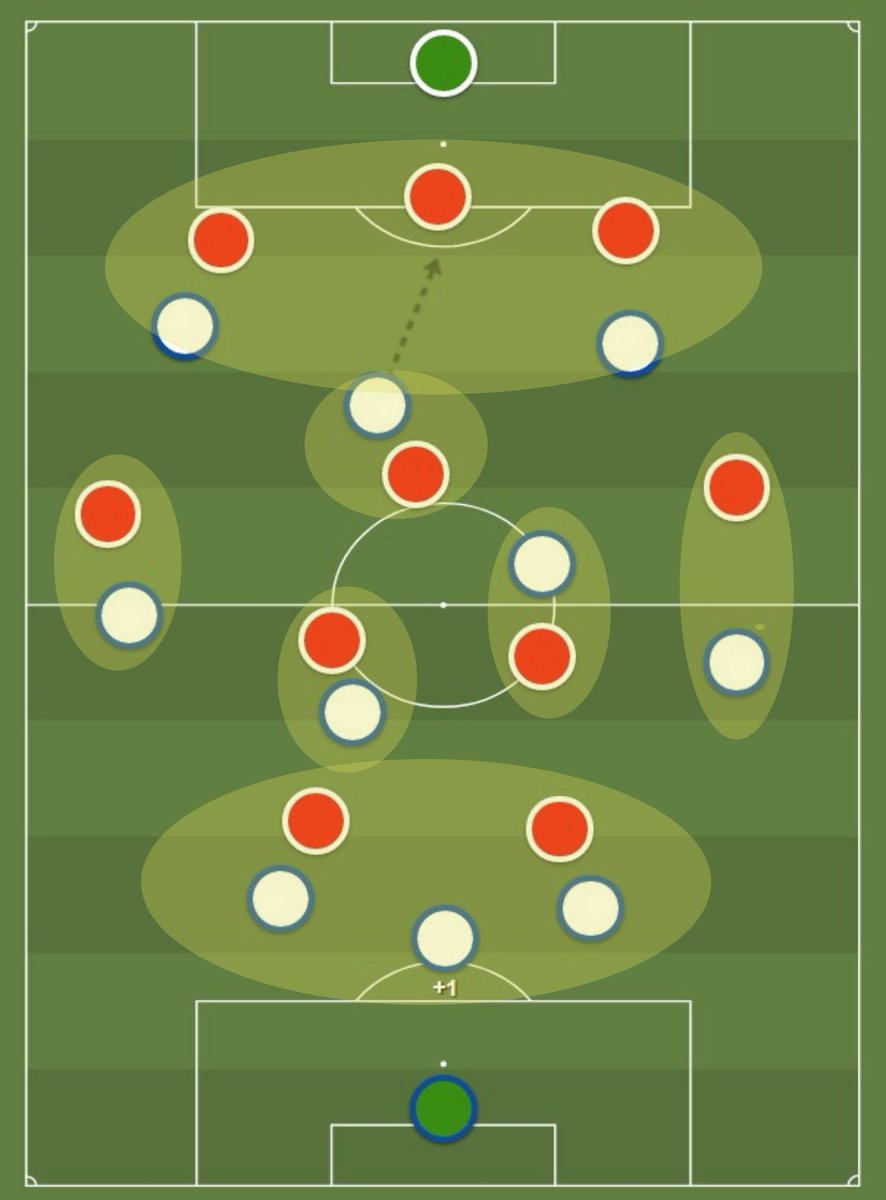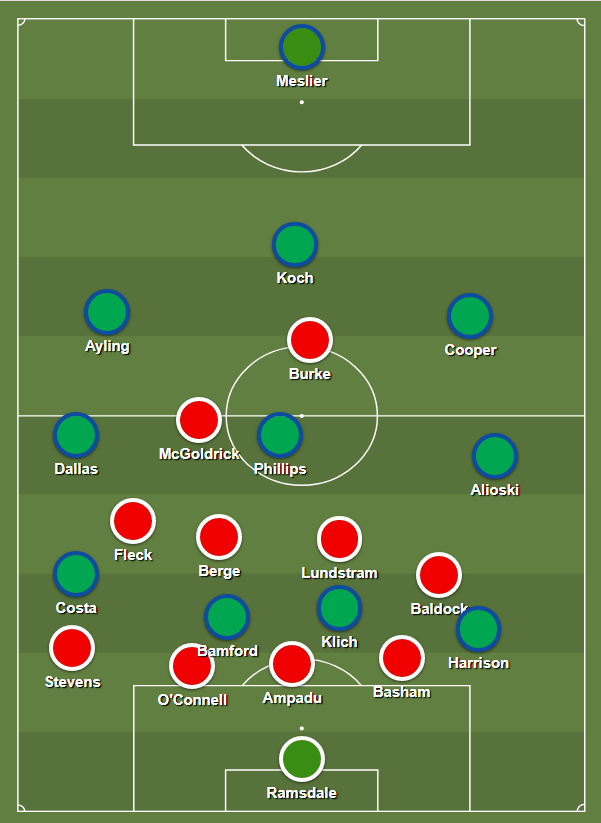Some tactical thoughts on Leeds’ trip to Brammall Lane on Sunday #lufc: [thread]
If Leeds’ opening fixture was a “free hit” against Liverpool and last weekend’s game against Fulham was a “must-win”, this Sunday’s clash with Sheffield United offers Leeds a benchmark for the sort of games that will determine their overall position this season.
Marcelo Bielsa and Chris Wilder have faced each other twice in league competitions now, albeit with a season between them now. Both games in the 2018/19 season were fascinating affairs for largely structural reasons.
If you’ve read anything about Sheffield United under Chris Wilder, odds are you will have read something about overlapping centre backs. But reducing the Blades to this tactical affectation is overly simplistic.
Wilder uses these groups of three to form the basis of his build-up play, using them to form overloads in wide areas, eventually working the ball into dangerous positions in the box.
I’ve drawn in the triangle of players who make up the right-sided unit. With the left centre back pushing so far forward, Sheffield United cause defensive headaches for oppositions.
The centre back and wing back can operate fairly fluidly in a way that allows them to lose their markers; something that will be an issue for Leeds.
But it’s not just the three right-sided players who engage in the overload. On the screengrab above, you can also see how the two strikers, Oli McBurnie and David McGoldrick, have drifted wide and deep to help the build up.
Width is the watchword for Chris Wilder’s approach. Running the clip above further on, we get to this point:
Again, I’ve drawn the right-sided triangle onto the screengrab. Notice now how the right-sided centre back, Chris Basham, is now more advanced than the two forwards.
But if you look over to the other side, you can see two of the three players in the left-sided triangle, giving wide options on the opposite side of the pitch. The third member of that triangle is Jack O’Connell who is back offering cover with John Egan, the central centre back.
Sheffield United, then, use interesting build up patterns that go against the norm and this is what made them such a tough prospect for Premier League sides this season.
For Leeds, this level of uniqueness is made doubly difficult by the fact that Leeds operate using a man-oriented system out of position.
As we know, Leeds use a +1 superiority at the back (a spare man) and a -1 inferiority up front (1 vs 2 or 2 vs 3):
Against an opponent who use a front two, Marcelo Bielsa will almost always go with a back three. The two outside centre backs will man mark the two strikers and the central defender will sit as a “libero”, as he calls it.
With a back three, Leeds will almost always form a 3-3-1-3 formation (the structure they will adopt situationally in attacking phases anyway).
However, against Sheffield United, this produces another problem. With a front three going up against a back three, you have too many players in the out of possession phase to mark the centre backs:
As you can see here, the central defensive midfielder isn’t marked at all.
How to solve this problem? Well, the way that Marcelo Bielsa has done this in the past is to use the two wide players as the man markers for the centre backs, pushing the forward back to mark the defensive midfielder...
You may remember in the Sheffield United fixture at Brammall Lane in 2018/19, Bielsa—on the advice of Pablo Quiroga—switched Kemar Roofe from centre forward to wide right and brought Pablo Hernandez into the middle in this system, playing as almost a false 9.
This defensive set up looks simple on paper, of course. But as we’ve already seen, Sheffield United use a level of horizontal fluidity.
Expect to see the two wide forwards, Jack Harrison and Helder Costa, covering a huge amount of space on Sunday as the centre backs overlap down the wide areas.
The next question is: who will play the wing back roles for Leeds?
For the most part last season, Leeds used Stuart Dallas in the right wing back slot. However, he largely played an inverted role, sitting alongside Kalvin Phillips with the left sided wing back playing as a more classic wing back:
This enabled Leeds to have a little more defensive cover in the middle and allowed Ayling to get forward as if he were a right back. Dallas also helped out in the build-up phase, with Leeds focusing a lot of their build-up down the right.
However, in this instance, the right wing back will have to match up to the Sheffield United left wing back, Enda Stevens. This means they will have to play a much more vertical role to the one Dallas played last season.
When Leeds played Sheffield United at Elland Road in the 18/19 season, Pablo Hernandez effectively played this position with Tyler Roberts filling in as the wide right player in the press.
This time around, this presents a selection headache. If you do go with Dallas as a right wing back, who do you play as the left wing back? Alioski? But won’t Bielsa want to use Alioski off the bench to replace whichever of Harrison or Costa tires first?
What about Barry Douglas? Leif Davis?
The whole Sheffield United structure raises so many questions of Leeds’ system that it will be interesting to see how they resolve.
As for attacking phases, Sheffield United have evolved during their time in the Premier League and are comfortable sitting deep in a block and then looking to decompress quickly:
This season, Wilder has brought in Oliver Burke as an outlet up front adding pace and directness to their attack. If Wilder decides to field Burke on Sunday, it might suggest he’s going to continue with their more pragmatic approach against Leeds.
However, with two losses to their name in the Premier League so far, Sheffield United will be looking to get off the mark and may come out a little more ambitiously and play McBurnie again with McGoldrick.
In the defensive midfield position, Oli Norwood has been recently superceded by Sander Berge. However, if Wilder looks to be more expansive, Norwood’s passing may be preferred.
These fixtures between Bielsa and Wilder have been entertaining in the past and there is little to suggest that Sunday’s offering won’t be similarly interesting from a tactical point of view.
If you prefer this in blog form: https://allstatsarentwe.substack.com/p/sheffield-united-vs-leeds-united">https://allstatsarentwe.substack.com/p/sheffie...
Or audio form: https://pod.fo/e/9d76e ">https://pod.fo/e/9d76e&q...
Check out our Patreon if you want to see what bonus material we have to offer: http://www.patreon.com/allstatsarentwe ">https://www.patreon.com/allstatsa...
If you& #39;ve got this far, why not retweet the original tweet in this thread to share the love?

 Read on Twitter
Read on Twitter